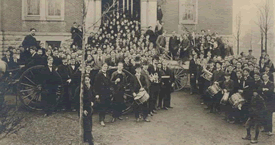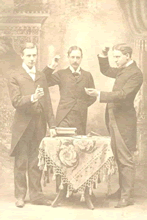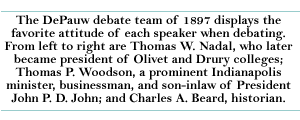
<<
Back
Oratory
and debate at DePauw is founded upon a long forensic tradition reaching
back into the Indiana Asbury period, with its emphasis on public
speaking in the literary societies and its graduates' inclination
toward such vocations as the ministry, law, and teaching. As early
as 1875 a branch of the Indiana Oratorical Association was founded
at Asbury, and in 1881 Charles Coffin won both the state and interstate
oratorical contests.


The next student to achieve that same double honor was Albert J.
Beveridge, later the distinguished U.S. Senator and historian. His
victory in 1885 set off an explosion of excitement on the DePauw
campus. On his return from the contest held in Columbus, Ohio, he
received an artillery salute at the railroad station and was escorted
to Meharry Hall by a brass band and military company. The faculty
declared a holiday from classes. During the next several years DePauw
won many state and a few interstate contests, all celebrated in
similar fashion, the victors accorded honors usually granted only
to heroes of the gridiron or baseball diamond. Few women participated,
but there was a special celebration when coed Jean Nelson won both
the state and interstate in 1892, defeating in the latter contest
the representatives of 62 colleges from 10 states.
By 1918 DePauw had won 19 out of 37 oratorical contests but only
five interstate contests, the last in 1905. David E. Lilienthal
won the last state contest in 1918 with a speech on "The Mission
of the Jew." There were other oratorical victories as well:
DePauw won 10 of 15 contests sponsored by the State Prohibition
League and four of seven in the state Peace oratorical contests
and two interstate contests.

DePauw also took an active part in intercollegiate debate in this
period, beginning with three consecutive victories over Indiana
University in 1894, 1895 and 1896. Student interest remained high
in this form of public speaking throughout the period, when DePauw
teams debated Earlham, Butler, Wabash, Notre Dame, and other colleges
to the accompaniment of campus enthusiasm similar to that shown
for intercollegiate sports.
Back
to Top
<< Back
|





